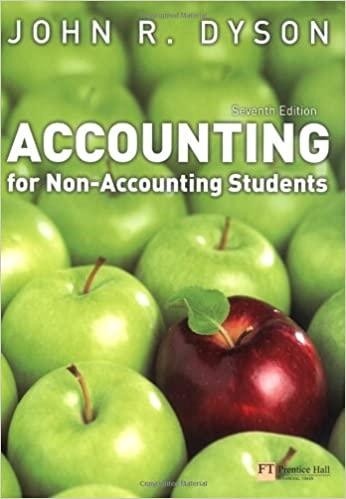Answered step by step
Verified Expert Solution
Question
1 Approved Answer
case study: the data is at the bottom Instructions: TV Listing Magazines Deliverable You have been hired as a consultant by TV Listings Magazines Inc.
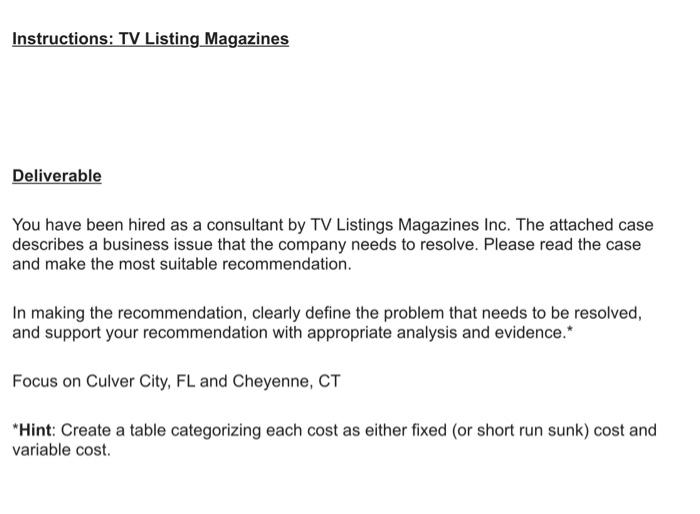
case study:
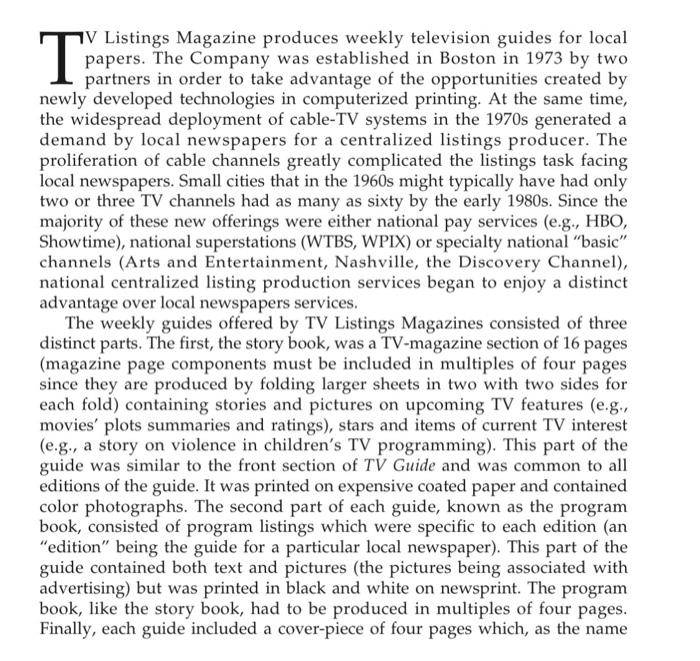
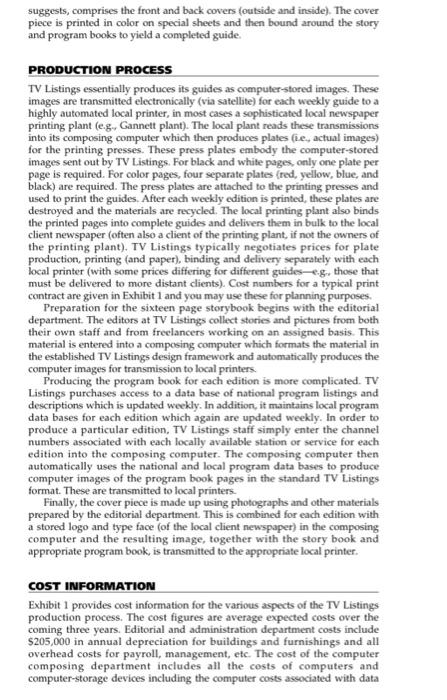
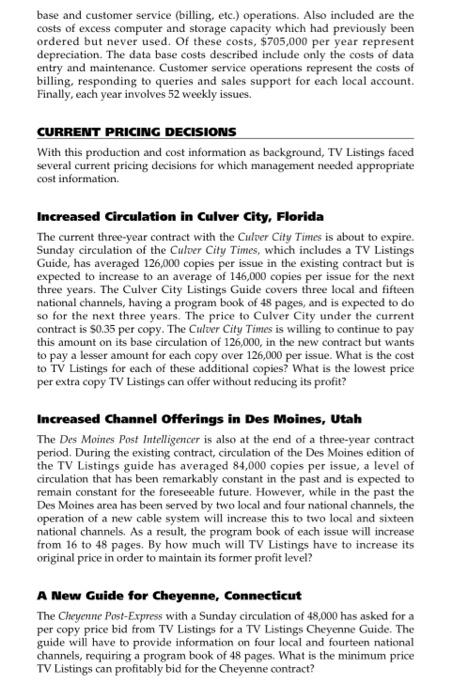
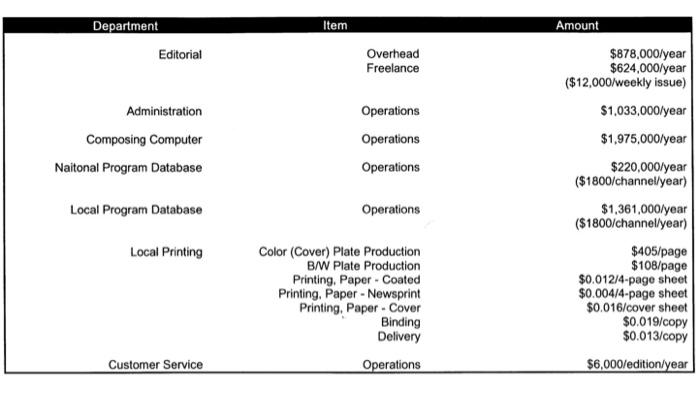
the data is at the bottom
Instructions: TV Listing Magazines Deliverable You have been hired as a consultant by TV Listings Magazines Inc. The attached case describes a business issue that the company needs to resolve. Please read the case and make the most suitable recommendation. In making the recommendation, clearly define the problem that needs to be resolved, and support your recommendation with appropriate analysis and evidence.* Focus on Culver City, FL and Cheyenne, CT "Hint: Create a table categorizing each cost as either fixed (or short run sunk) cost and variable cost. TV Listings Magazine produces weekly television guides for local papers. The Company was established in Boston in 1973 by two partners in order to take advantage of the opportunities created by newly developed technologies in computerized printing. At the same time, the widespread deployment of cable-TV systems in the 1970 s generated a demand by local newspapers for a centralized listings producer. The proliferation of cable channels greatly complicated the listings task facing local newspapers. Small cities that in the 1960 s might typically have had only two or three TV channels had as many as sixty by the early 1980 s. Since the majority of these new offerings were either national pay services (e.g., HBO, Showtime), national superstations (WTBS, WPIX) or specialty national "basic" channels (Arts and Entertainment, Nashville, the Discovery Channel), national centralized listing production services began to enjoy a distinct advantage over local newspapers services. The weekly guides offered by TV Listings Magazines consisted of three distinct parts. The first, the story book, was a TV-magazine section of 16 pages (magazine page components must be included in multiples of four pages since they are produced by folding larger sheets in two with two sides for each fold) containing stories and pictures on upcoming TV features (e.g., movies' plots summaries and ratings), stars and items of current TV interest (e.g., a story on violence in children's TV programming). This part of the guide was similar to the front section of TV Guide and was common to all editions of the guide. It was printed on expensive coated paper and contained color photographs. The second part of each guide, known as the program book, consisted of program listings which were specific to each edition (an "edition" being the guide for a particular local newspaper). This part of the guide contained both text and pictures (the pictures being associated with advertising) but was printed in black and white on newsprint. The program book, like the story book, had to be produced in multiples of four pages. Finally, each guide included a cover-piece of four pages which, as the name suggests, comprises the front and back covers (outside and inside). The cover piece is printed in color on special sheets and then bound around the story and program books to yield a completed guide. PRODUCTION PROCASS TV Listings essentially produces its guides as computer-stored images. These images are transmitted electronically (via satellite) for each weekly guide to a highly automated local printer, in most cases a sophisticated local newspaper printing plant (e.g. Gannett plant). The local plant reads these transmissions into its composing computer which then produces plates (i.e., actual images) for the printing presses. These press plates embody the computer-stored images sent out by TV Listings. For black and white pages, only one plate per page is required. For color pages, four separate plates (red, yellow, blue, and black) are required. The press plates are attached to the printing presses and used to print the guides. After each weekly edition is printed, these plates are destroyed and the materials are recycled. The local printing plant also binds the printed pages into complete guides and delivers them in bulk to the local client newspaper (often also a client of the printing plant, if not the owners of the printing plant). TV Listings typically negotiates prices for plate production, printing (and paper), binding and delivery separately with each local printer (with some prices differing for different guides-e.g. those that must be delivered to more distant clients). Cost numbers for a typical print contract are given in Exhibit 1 and you may use these for planning purposes. Preparation for the sixteen page storybook begins with the editorial department. The editors at TV Listings collect stories and pictures from both their own staff and from freelancers working on an assigned basis. This material is entered into a composing computer which formats the material in the established TV Listings design framework and automatically produces the computer images for transmission to local printers. Producing the program book for each edition is more complicated. TV Listings purchases access to a data base of national program listings and descriptions which is updated weekly. In addition, it maintains local program data bases for each edition which again are updated weekly. In order to produce a particular edition. TV Listings staff simply enter the channel numbers associated with each locally available station or service for each edition into the composing computer. The composing computer then automatically uses the national and local program data bases to produce computer images of the program book pages in the standard TV Listings format. These are transmitted to local printers. Finally, the cover piece is made up using photographs and other materials prepared by the editorial department. This is combined for each edition with a stored logo and type face (of the local client newspaper) in the composing computer and the resulting image, together with the story book and appropriate program book, is transmitted to the appropriate local printer. COST INFORMATIOM Exhibit 1 provides cost information for the various aspects of the TV Listings production process. The cost figures are average expected costs over the coming three years. Editorial and administration department costs include $205,000 in annual depreciation for buildings and furnishings and all overhead costs for payroll, management, etc. The cost of the computer composing department includes all the costs of computers and computer-storage devices including the computer costs associated with data base and customer service (billing, etc.) operations. Also included are the costs of excess computer and storage capacity which had previously been ordered but never used. Of these costs, $705,000 per year represent depreciation. The data base costs described include only the costs of data entry and maintenance. Customer service operations represent the costs of billing, responding to queries and sales support for each local account. Finally, each year involves 52 weekly issues. CURRENT PRICING DECISIONS With this production and cost information as background, TV Listings faced several current pricing decisions for which management needed appropriate cost information. Increased Circulation in Culver City, Florida The current three-year contract with the Culver City Times is about to expire. Sunday circulation of the Culver City Times, which includes a TV Listings Guide, has averaged 126,000 copies per issue in the existing contract but is expected to increase to an average of 146,000 copies per issue for the next three years. The Culver City Listings Guide covers three local and fifteen national channels, having a program book of 48 pages, and is expected to do so for the next three years. The price to Culver City under the current contract is $0.35 per copy. The Culver City Times is willing to continue to pay this amount on its base circulation of 126,000 , in the new contract but wants to pay a lesser amount for each copy over 126,000 per issue. What is the cost to TV Listings for each of these additional copies? What is the lowest price per extra copy TV Listings can offer without reducing its profit? Increased Channel Offerings in Des Moines, Utah The Des Moines Post Intelligencer is also at the end of a three-year contract period. During the existing contract, circulation of the Des Moines edition of the TV Listings guide has averaged 84,000 copies per issue, a level of circulation that has been remarkably constant in the past and is expected to remain constant for the foreseeable future. However, while in the past the Des Moines area has been served by two local and four national channels, the operation of a new cable system will increase this to two local and sixteen national channels. As a result, the program book of each issue will increase from 16 to 48 pages. By how much will TV Listings have to increase its original price in order to maintain its former profit level? A Mew Guide for Cheyenne, Connecticut The Chryenne Post-Express with a Sunday circulation of 48,000 has asked for a per copy price bid from TV Listings for a TV Listings Cheyenne Guide. The guide will have to provide information on four local and fourteen national channels, requiring a program book of 48 pages. What is the minimum price TV Listings can profitably bid for the Cheyenne contract? Department Item Amount Step by Step Solution
There are 3 Steps involved in it
Step: 1

Get Instant Access to Expert-Tailored Solutions
See step-by-step solutions with expert insights and AI powered tools for academic success
Step: 2

Step: 3

Ace Your Homework with AI
Get the answers you need in no time with our AI-driven, step-by-step assistance
Get Started


